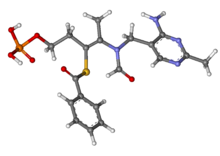벤포티아민
Benfotiamine | |
 | |
| 임상자료 | |
|---|---|
| 상명 | 밀감마 |
| 기타 이름 | S-벤조일티아민 O-모노인산염 |
| AHFS/Drugs.com | 국제 마약 이름 |
| 경로: 행정 | 구강 |
| ATC 코드 | |
| 법적현황 | |
| 법적현황 |
|
| 식별자 | |
| |
| CAS 번호 | |
| 펍켐 CID | |
| 켐스파이더 | |
| 유니 | |
| 체비 | |
| 켐벨 | |
| CompTox 대시보드 (EPA) | |
| ECHA InfoCard | 100.040.906 |
| 화학 및 물리적 데이터 | |
| 공식 | C19H23N4O6PS |
| 어금질량 | 466.45 g·190−1 |
| 3D 모델(JSmol) | |
| |
| |
| | |
벤포티아민(RINN, 또는 S-Benzoylthiamine O-monophosphate)은 합성 지방 용해성 티아민(Vitamin B1)의 S-acyl 유도체로, 당뇨병 센서리모터 다신증(densor polyneuropathis)을 치료하는 약물이나 식이요법으로서 일부 국가에서 승인되었다.벤포티아민은 1950년대 후반 일본에서 개발되었다.[1][2]
사용하다
벤포티아민은 당뇨병성 다신증 치료를 위한 처방전 없이 살 수 있는 약으로 주로 시판되고 있다.[3]2021년 검토에서는 두 차례의 임상실험을 기술하고 더 많은 연구가 필요하다는 결론을 내렸다.[4]
2017년 현재 벤포티아민은 많은 국가에서 다음과 같은 상표명으로 의약품으로 시판되었다.베날기스, 벤포게마, 벤포스,[5] 벤포티아미나, 비오타민, 비오토와, 밀감마, 빌로트람.또한 일부 관할구역에서는 밀감마(Milgamma)로 시아노코발라민을, 밀감마(Milgamma)로 피리독신을, 벤포스-M으로 메트포민, 비타포스(Vitafos)로 티아민과 결합한 복합제로서 시판되기도 했다.[5]
역효과
부작용에 대한 발표된 자료는 거의 없다.벤포티아민, 피리독신, 시아노코발라민의 조합에 대한 한 연구에서 약 8%의 사람들이 메스꺼움, 현기증, 복통, 체중 증가를 경험했다.[6]
약리학
벤포티아민은 장 점막에 존재하는 엑토알칼린인산염에 의해 S-벤조일탈티아민에 비인산화되어 간에서 티오에스테라제에 의해 티아민에 가수분해된다.[7]벤포티아민은 티아민 소금보다 생체이용성이 높아 근육, 뇌, 간, 신장 등에 티아민을 더 많이 공급한다.[8][6]
벤포티아민은 주로 트랜스케톨라제 활동의 증가를 통해 말초 조직에 작용한다.[7][6][9]
화학
벤포티아민은 티아민의 지질 유도체로서, 특히 합성 S-아킬 비타민1 B의 아날로그이다. 화학적 이름은 S-벤조일티아민 O-모노인산염이다.[10]그것은 물이나 다른 수용성 용매에서 용해도가 매우 낮다.[7]
리서치
벤포티아민은 당뇨망막병증, 신경병증, 신혈증의 실험실 모델에서 연구되어 왔다.[10]2021년 검토에서는 두 차례의 임상실험을 기술하고 더 많은 연구가 필요하다는 결론을 내렸다.[4]
벤포티아민을 투여하면 트랜스케톨라제의 공동작용제인 티아민 디포스포산염의 세포내 수치가 증가할 수 있으며,[10] 알츠하이머병의 대사이론에 근거해 알츠하이머병의 임상 전 모델에서 연구되어 왔다.[11][clarification needed]
참조
- ^ Wada, T; Takagi, H; Minakami, H; Hamanaka, W; Okamoto, K; Ito, A; Sahashi, Y (21 July 1961). "A New Thiamine Derivative, S-Benzoylthiamine O-Monophosphate". Science. 134 (3473): 195–96. Bibcode:1961Sci...134..195W. doi:10.1126/science.134.3473.195. PMID 13782394. S2CID 10384617.
- ^ Sambon, Margaux; Wins, Pierre; Bettendorff, Lucien (2021-05-21). "Neuroprotective Effects of Thiamine and Precursors with Higher Bioavailability: Focus on Benfotiamine and Dibenzoylthiamine". International Journal of Molecular Sciences. 22 (11): 5418. doi:10.3390/ijms22115418. ISSN 1422-0067. PMC 8196556. PMID 34063830.
- ^ McCarty, MF; Inoguchi, T (2008). "11. Targeting Oxidant Stress as a Strategy for Preventing Vascular Complications of Diabetes and Metabolic Syndrome". In Pasupuleti, Vijai K.; Anderson, James W. (eds.). Nutraceuticals, glycemic health and type 2 diabetes (1st ed.). Ames, Iowa: Wiley-Blackwell/IFT Press. p. 213. ISBN 9780813804286.
- ^ a b Zaheer A, Zaheer F, Saeed H, Tahir Z, Tahir MW (April 2021). "A Review of Alternative Treatment Options in Diabetic Polyneuropathy". Cureus. 13 (4): e14600. doi:10.7759/cureus.14600. PMC 8139599. PMID 34040901.
- ^ a b "Benfotiamine International brands". Drugs.com. Retrieved 14 March 2017.
- ^ a b c Panel on Food Additives and Nutrient Sources added to Food (2008). "Scientific Opinion: Benfotiamine, thiamine monophosphate chloride and thiamine pyrophosphate chloride, as sources of vitamin B1 added for nutritional purposes to food supplements" (PDF). The EFSA Journal. 864: 1–31.
- ^ a b c Patel, SM; Patel, RP; Prajapati, BG (2012). Patel, S (ed.). "Solubility enhancement of benfotiamine, a lipid derivative of thiamine by solid dispersion technique". Journal of Pharmacy & Bioallied Sciences. US National Library of Medicine and National Institutes of Health: J Pharm Bioallied Sci. 4 (Suppl 1): S104–S105. doi:10.4103/0975-7406.94157. PMC 3467834. PMID 23066179.
- ^ Bitsch, R; Wolf, M; Moeller, J; Heuzeroth, L; Grueneklee, D (1991). "Bioavailability Assessment of the Lipophilic Benfotiamine as Compared to a Water-Soluble Thiamin Derivative". Ann Nutr Metab. 35 (5): 292–96. doi:10.1159/000177659. PMID 1776825.
- ^ Yamazaki, M (1968). "Studies on the absorption of S-benzoylthiamine O-monophosphate : (I) Metabolism in tissue homogenates". Vitamins. 38 (1): 12–20.
- ^ a b c Balakumar P, Rohilla A, Krishan P, Solairaj P, Thangathirupathi A (June 2010). "The multifaceted therapeutic potential of benfotiamine". Pharmacol Res. 61 (6): 482–88. doi:10.1016/j.phrs.2010.02.008. PMID 20188835.
- ^ Gibson, GE; Hirsch, JA; Cirio, RT; Jordan, BD; Fonzetti, P; Elder, J (July 2013). "Abnormal thiamine-dependent processes in Alzheimer's Disease. Lessons from diabetes". Molecular and Cellular Neurosciences. 55: 17–25. doi:10.1016/j.mcn.2012.09.001. PMC 3609887. PMID 22982063.


